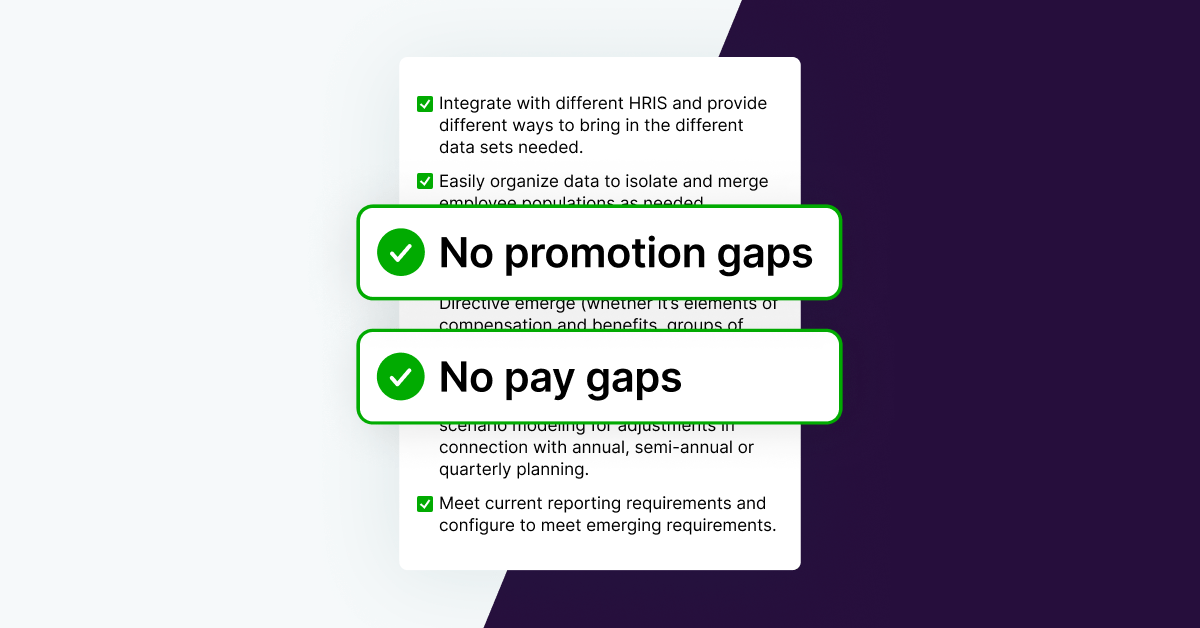As U.S. Equal Pay Day approaches, it presents a prime opportunity for companies to underscore their commitment to fostering workplace equity. However, making a meaningful statement requires more than just a performative mention on social media or in a company-wide meeting. Today’s employees and the broader American public are increasingly attuned to issues of fairness, and sensitive to empty “social washing” statements.
So, how can companies communicate about pay gaps and workplace fairness on U.S. Equal Pay Day with sincerity and substance?
Global enterprises leverage Syndio’s technology and expertise to help close their unadjusted pay gaps and achieve pay equity, and communicate clearly about their progress. Below we share our experts’ top advice for companies gearing up for Equal Pay Day communications.
What do Equal Pay Day communications look like?
We see companies take a variety of approaches to Equal Pay Day communications depending on their desired level of transparency. At the low end of the transparency spectrum, companies may acknowledge the importance of equal pay and their commitment to achieving it.
Organizations who have embraced greater transparency may disclose their pay equity and/or unadjusted pay gap numbers, either through internal communications such as announcements in company-wide emails or All Hands meetings, or perhaps even publicly.
We’ve also seen some leading companies develop educational resources or host events such as panels or webinars discussing what pay gaps are and how they can be tackled. For example, check out HCI’s 2023 Equal Pay Day webinar on getting pay equity right.
5 tips for Equal Pay Day communications
1. Set the right tone.
Keep in mind that Equal Pay Day is an “anti-holiday” — a stark reminder of the persistent pay gap. It symbolizes how far into the year the average woman must work in order to earn what the average man earned in the previous year. In a perfect world, everyone would be paid fairly for their work and would have fair opportunities for advancement, making Equal Pay Day obsolete. So, even if you’re sharing positive progress on your company’s pay equity or pay gap numbers, avoid grand-standing and self-congratulations. The pay gap continues to exist at large for the majority of working women, with real-life impacts on real people, so be sure to acknowledge the work that still needs to be done.
Additionally, the name “Equal Pay Day” is an oversimplification. It’s actually part of a broader season highlighting the varied experiences of the pay gap for women from different backgrounds, including:
- Asian American, Native Hawaiian and Pacific Islander Women’s Equal Pay Day — April 3 in 2024
- LGBTQIA+ Equal Pay Awareness Day — June 13 in 2024
- Black Women’s Equal Pay Day — July 9 in 2024
- Moms’ Equal Pay Day — August 7 in 2024
- Native Hawaiian and Pacific Islander Women’s Equal Pay Day — August 28 in 2024
- Latina’s Equal Pay Day – October 3 in 2024
- Native Women’s Equal Pay Day – November 21 in 2024
This “Equal Pay Season” underscores the importance of applying an intersectional lens when discussing the nuances of pay gaps. Conducting intersectional analyses demonstrates inclusivity and a commitment to addressing disparities for everyone.
Finally, know that it’s okay to share numbers that aren’t “perfect”. Achieving a pay gap of zero is extremely challenging due to the dynamic nature of the workforce and the complex, interconnected nature of root causes. Being humble and transparent about where you currently stand (even if it’s not ideal), and showing the efforts and investments you’re making to fix issues will go a long way towards building trust.
2. Clarify the difference between adjusted and unadjusted pay gaps.
Keep your audience in mind! There are a lot of similar-but-distinct terms in the world of workplace equity which are easy to confuse, especially because most employees aren’t steeped in HR and Total Rewards lingo. Simplify complex ideas into straightforward, relatable language. When discussing pay equity, clearly differentiate between “adjusted” and “unadjusted” pay gaps, providing clear definitions and examples to illuminate these concepts.
What is the median pay gap?
Many companies lead with their adjusted pay gap, often presented as a “cents on the dollar” summary statistic. However, focusing solely on this can lead to an oversimplified understanding of workplace equity issues. Plus, chasing a perfect dollar-for-dollar stat can sometimes result in unfair overcorrections by eliminating wanted differentiation in pay for different roles. The unadjusted pay gap offers crucial insights into systemic inequalities driving overall disparities that span pay and opportunities.
Regardless of which number you share, providing context is key. Explain what these numbers signify and their limitations. For instance, an adjusted pay gap may suggest inequitable pay in equivalent roles, or highlight small sample sizes leading to statistical noise in the measure. An unadjusted pay gap may highlight a lack of representation in higher paid roles, or occupational segregation common in certain roles and industries.
Consider leveraging software like Syndio’s Workplace Equity Analytics Platform to pinpoint and explain your pay gaps. By identifying specific areas within your organization where disparities are most pronounced and investigating their origins and implications, you can wrap an informed narrative around your pay gap numbers to explain why they exist.
For example, if all of your engineering managers are men, they’ll raise the average pay for men in engineering, causing an unadjusted gender gap in engineering. Syndio’s platform helps you understand what your representation looks like relative to what it could look like (based on your internal talent availability and/or labor pool data) to determine actions you can take to address this unadjusted gap in engineering.
Get the Glossary of Workplace Equity Terms >
3. Equip managers with talking points, since employees who have questions will go to their managers.
Anticipate that sharing information on pay equity and pay gaps will prompt questions from employees — and the first line receiving those questions will likely be their managers. To help them feel equipped to respond, it’s essential to arm your management team with comprehensive resources and clear communication about what will be shared company-wide. This preparation not only boosts their confidence in addressing questions but also ensures consistency in the information disseminated.
Consider providing managers with the following tools and information in advance:
- A prepared Q&A sheet: Compile a list of frequently asked questions you anticipate from employees, complete with thoughtful, accurate answers. Employees will likely be asking how this affects them personally, so prepare managers to answer those questions.
- Key terminology definitions: Equip managers with simple, clear definitions of essential pay gap terms. This glossary will help them explain complex concepts in accessible language, making it easier for all employees to understand the discussion.
- Breakdown of pay gap figures: Offer a detailed explanation of your organization’s pay gap data, including how these numbers were calculated and what they signify. Transparency about the methodology and meaning behind these figures is crucial for credibility and trust.
- Outline of actionable steps: Detail the specific measures your company is taking to address pay inequities and gaps. Providing concrete examples of initiatives underway or planned can help reassure employees about the company’s commitment to change.
By preparing managers — whether through emails, the Intranet, internal webinars, or training sessions — you not only facilitate a smoother communication process but also empower your leaders to navigate sensitive discussions with assurance and empathy.
Read Pay Transparency Training for Managers: 5 Strategies for Effective Communication about Pay >
4. Be prepared for pushback by ensuring your claims are backed by data analytics.
Last International Women’s Day illustrated the pitfalls of performative allyship, as a Gender Pay Gap Bot publicly called out companies for sharing superficial platitudes on social media by revealing their unadjusted pay gaps. This incident underscores the importance of authenticity over optics.
The solution? Don’t be performative. People are quick to scrutinize lip service and empty gestures on social media. If your statements of commitment to gender pay equity aren’t backed by concrete data and actionable steps, they might do more harm than good.
To counter skepticism, arm your communications with robust data analytics and an action plan. Demonstrating the substance behind your claims through transparent data sharing not only builds credibility, but also showcases a genuine commitment to addressing pay disparities.
5. Highlight the initiatives you’ve been working on and plan to do in order to impact your pay gap.
Closing unadjusted pay gaps isn’t an overnight fix. It requires sustained efforts over time across the organization to ensure that employees are paid, promoted, and advanced equitably. So it’s understandable if your organization still has an unadjusted pay gap — as long as you have a concrete plan to make progress.
In your messaging, highlight the efforts underway, the solutions in use, and future steps. Be specific about the interventions you are taking or planning to take to address the root causes you’ve identified. Acknowledging the complexity, detailing your investments, and committing to long-term solutions shows that you’re putting your money where your mouth is to make real change.
6. Bonus for next year: Consider a third-party certification to add weight and credibility to your workplace equity communications.
“It’s not easy for companies to just start talking about pay equity… The Fair Pay Workplace certification allowed us to talk about what we’re doing, talk about the approach that we take… And we’ve also used our disclosures to talk about our [pay equity] journey, what we’re doing in this space.”
– Kim Wicker, VP of Executive Compensation, American Airlines
To further validate your efforts and communicate your commitment to equitable pay practices, consider obtaining third-party certifications, such as Fair Pay Workplace. These endorsements can enhance your credibility and demonstrate your investment in creating a fair and equitable workplace.
In this video, Kim Wicker, VP of Executive Compensation at American Airlines, shares how they’ve turned workplace equity into a brand communications advantage. American Airlines leveraged Syndio’s PayEQ® solution to ensure fair pay practices through in-depth pay equity analyses . After achieving certification from Fair Pay Workplace, they felt more confident adopting pay transparency: openly discussing their equity achievements and milestones in communications.
Want to build trust? Mean what you say and prove what you say.
Engaging in the Equal Pay Day conversation is a chance to reflect on your company’s progress and recommit to closing the pay gap. It’s about more than just one day: it’s an ongoing commitment to equity and transparency. By setting the right tone, clarifying complex topics, equipping your team, backing claims with data, showcasing genuine efforts, and seeking third-party validation, you can build trust and contribute to meaningful progress.
Remember: Actions speak louder than words. Let your commitment to closing the pay gap be evident not just in what you say, but in what you do.
Want more workplace equity communications advice? Check out our bundle of workplace equity communications resources, including a step-by-step playbook, a lookbook featuring real-world communications examples from 20+ companies, and tips from a leading communications consultant.
The information provided herein does not, and is not intended to, constitute legal advice. All information, content, and materials are provided for general informational purposes only. The links to third-party or government websites are offered for the convenience of the reader; Syndio is not responsible for the contents on linked pages.


